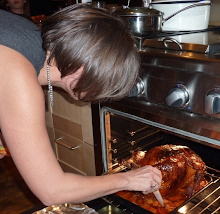Emptying out the freezer and getting it ready for the arrival of the quarter pig, I found some oven roasted tomatoes and garlic that I had made at the end of the last tomato season. Perfect starting point for the albondigas.
The trick is to put all the seasonings in the meatballs, and leave the tomatoes fairly unseasoned. And then cook everything until the tomato sauce comes together in a very thick sauce, at least an hour, if you have time better two. And if you have more time let it cool down, and reheat it the next day for perfect flavor!
In the meantime get the tomatoes heated. I used my oven roasted tomatoes, and a small can of high quality canned tomatoes. In the summer I use fresh tomatoes, I'll just have to let it simmer longer, but the taste is out of this world. When the tomatoes are simmering, carefully add the meatballs to the sauce, bring back to a light simmer, put a lid on, and go on with life.
This is at the beginning of the process, two hours later it's very thick and very red and very yummy! (Note to self: next time pick out the tomato skins before freezing them.) And duh, of course, I forgot to take a photo of the finished product, I was hungry! I promise to take a photo of the whole goodness the next time.
Recipes:
Ulrich's Albondigas
2 lbs tomatoes, fresh or roasted (see below)
- or -
28 oz can of good quality canned tomatoes, e.g. fire roasted Muir Woods
- or -
any mixture thereof
1 lb ground beef
6 garlic cloves
1 chipotle in adobo sauce, minced, or 1 fresh chili
salt - very little if using canned tomoatoes, a bit more if using real tomatoes.
Heat tomatoes in a medium pot. Chop garlic and chili, add to ground beef, form little 1" diameter meatballs. When the tomatoes are heated, carefully add the meatballs, stirring as little as possible until they have firmed up. Leave on stove at low heat for at least 2 hours, stirring every once in a while, until the sauce has thickened.
Serve with fresh crusty bread.
Oven Roasted Tomatoes
When you see a good deal on tomatoes (I usually find them on the Farmers Market late in the season when people are sick of tomatoes) buy as many as you can handle / afford / stick in your freezer. Or, if you are lucky enough to be a good gardener, use your own (and watch me turn green with envy!) Wash, cut in half, put them on cookie sheets, cut side up, slightly salt, pepper, add some garlic cloves or herbs if you have, and stick in the oven at 300 with convection. Convection helps dry out the tomatoes, and you can pack your oven with several sheets at once. Timing? I've had them in there anywhere between 30 minutes and 1 1/2 hours, depending on the tomatoes, the humidity, the amount of tomatoes, just keep an eye on them. When they start shriveling up, take out and let cool down, take off the skins (!), then freeze. You'll thank me in the winter!























